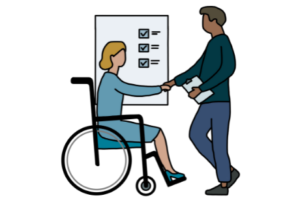 Example of a Volunteer Induction Checklist
Example of a Volunteer Induction Checklist
Outline of general areas to be covered in an induction process:
- Practicalities to support comfort
- Introductions to their supervisor and colleagues or other volunteers
- A breakdown of their tasks including risk assessments and safe ways of working
- The structure of the museum or heritage organisation
- Important policies such as Safeguarding; Health and Safety; and your Volunteer Policy
- What to do in the event of an emergency
- How to deal with problems
- A training schedule – including training with the museum’s emergency plan
- How volunteers are supported including communication channels
- Details about the history of your organisation
Tips for successfully managing an induction:
Pace the induction appropriately according to individual needs. Start with the basics that they’ll need for their own comfort and safety. Then move onto their role and your organisation’s mission. Gradually introduce policies and plans.
Vary the timing, pace and type of induction activity – don’t overload people with either reading or formal meetings on their first day.
Be aware of differing learning styles and personalities and cater for all. Consider all these induction opportunities: reading a blog, website or handbook; going for a lecture, tour, chat, team catch up; shadowing; reading handover notes; raising queries in person, over the phone, or by email…
Be open: provide different kinds of opportunities for people to make connections across the organisation and understand current activity, but don’t try to cover it too quickly. Give time (and different avenues) for checking understanding in the early weeks.
Adapt this induction checklist template for your museum.
[This is a template. Adapt it for your own policies and working practices.]
| Induction Stage | Signed and Dated
by volunteer |
Signed and Dated
by supervisor |
| Personal information and emergency contact filled in | ||
| Shown where to sign in and sign out | ||
| Work place familiarisation (offices toilets, members of staff, front of house staff, other volunteers) | ||
| Handbook received, read and understood | ||
| Fire escapes and where to meet in case of fire alarm | ||
| Introduced to first-aiders | ||
| Hours and activities or project agreed | ||
| Appearance requirements explained and badge supplied if appropriate | ||
| Health & Safety Induction including fire procedures, accidents and manual | ||
| Risk Assessment read and understood | ||
| Equality and Diversity Policy read and understood | ||
| Safeguarding Guidelines read and understood | ||
| Expenses procedures explained and understood |
